key PONTIAC FIREBIRD 1998 Owner's Manual
[x] Cancel search | Manufacturer: PONTIAC, Model Year: 1998, Model line: FIREBIRD, Model: PONTIAC FIREBIRD 1998Pages: 406, PDF Size: 18.23 MB
Page 77 of 406

Theft-Deterrent Arming Verification
Your vehicle comes with this feature set in Mode 3. To
change the factory setting, do the following:
1. Press the LOCK button on the remote keyless
entry transmitter.
2. Count the number of chimes you hear. The number of
chimes
tells you which mode your vehicle is set for.
3. Press the LOCK button on the remote keyless entry
transmitter until you hear the number of chimes that
corresponds to the
mode selection you want.
Mode 1: All Off (No horn chrrps or parking lamp flash.)
Mode 2: Horn and Lamps (Your parking lamps will
flash and your horn will chirp twice to verify the system
is armed using any arming method.)
Mode 3: Horn and LampsLamps (If you use the remote
keyless entry transmitter to
arm the system, your
parking lamps will flash and your horn will chup twice
to verify that the system is armed.
If it only chqs once,
the hatch is open or unlatched. If you use either the
power door lock switch or passive arming, only your
lamps will flash for verification.)
Mode 4: Lamps (When your vehicle arms, only your
parking lamps will flash for verification.)
Driver’s Door Alarm Delay and Shock
Sensor Enable
Your vehicle comes with this feature set in Mode 4. To
change the factory setting, do the following:
1. Turn the parking lamps on and off.
2. Count the number of chimes you hear. The number of
chimes
tells you which mode your vehicle is set for.
3. Turn the parking lamps on and off until you hear the
number of chimes that corresponds to the mode
selection you want.
Mode 1: Zero Delay and Shock Sensor Disabled (The
alarm will sound immediately if the driver’s door is
opened with your key and the shock sensor will not be
available to measure sharp blows to your vehicle.)
Mode 2: Eight-Second Delay and Shock Sensor
Disabled (The
alarm will sound eight seconds after the
driver’s door is opened with your key and the shock
sensor will not be available to measure sharp blows to
your vehicle.)
2-22
Page 78 of 406
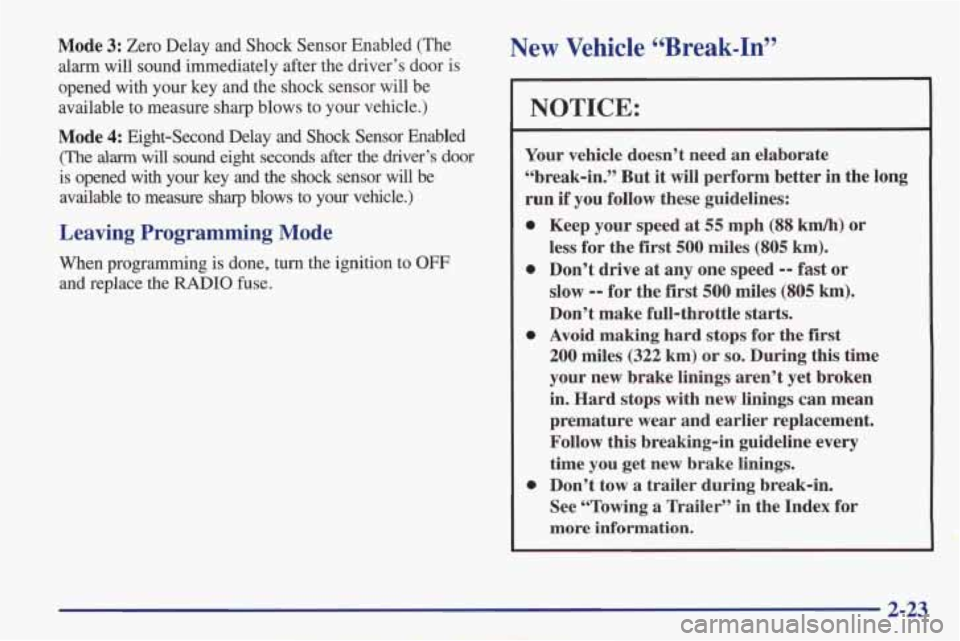
Mode 3: Zero Delay and Shock Sensor Enabled (The
alarm will sound immediately after the driver’s door is
opened with your key and the shock sensor will be
available to measure sharp blows to your vehicle.)
Mode
4: Eight-Second Delay and Shock Sensor Enabled
(The alarm will sound eight seconds after the driver’s door
is
opened with your key and the shock sensor will be
available to measure sharp blows to your vehicle.)
Leaving Programming Mode
When programming is done, turn the ignition to OFF
and replace the RADIO fuse.
New Vehicle CCBreak-InS’
NOTICE:
Your vehicle doesn’t need an elaborate
“break-in.” But it will perform better
in the long
run
if you follow these guidelines:
0 Keep your speed at 55 mph (88 km/h) or
less for the
first 500 miles (805 km).
0 Don’t drive at any one speed -- fast or
slow
-- for the first 500 miles (805 km).
Don’t make full-throttle starts.
200 miles (322 km) or so. During this time
your new brake linings aren’t yet broken
in. Hard stops with new linings can mean
premature wear and earlier replacement.
Follow this breaking-in guideline every
time you get new brake linings.
See “Towing a Trailer’’ in the Index for
more information.
0 Avoid making hard stops for the first
0 Don’t tow a trailer during break-in.
2-23
Page 79 of 406

Ignition Positions
C
1
A i E
With the ignition key in the ignition, you can turn the
switch to five positions.
ACC (A): Position in which you can operate your
electrical power accessories. Push in the ignition switch
as you turn
it toward you.
LOCK (B): The only position from which you can
remove the key. This locks your steering wheel, ignition
and automatic transmission.
If you have an automatic transmission, the ignition
switch can’t be turned to
LOCK unless the shift lever is
in
PARK (P).
OFF (C): Unlocks the steering wheel, ignition and
automatic transmission, but does not send electrical
power to any accessories. Use this position if your
vehicle must be pushed or towed.
A warning tone will
sound
if you open the driver’s door when the ignition is
off and the key is in the ignition.
RUN (D): Position to which the switch returns after you
start your engine and release the switch. The switch
stays
in RUN when the engine is running. But even
when the engine
is not running, you can use RUN to
operate your electrical power accessories and to display some instrument panel warning and indicator lights.
START (E): Starts the engine. When the engine starts,
release the key. The ignition will return to RUN for
normal driving.
2-24
Page 80 of 406

Note that even if the engine is not running, ACC and
RUN allow you to operate your electrical accessories,
such as the radio and ventilation fan.
A CAUTION:
On manual transmission vehicles, turning the key
to
LOCK will lock the steering column and result
in a loss of ability to steer the vehicle. This could
cause a collision.
If you need to turn the engine
off while the vehicle is moving, turn the key only
to
OFF. Don’t press the key release button while
the vehicle is moving.
NOTICE:
If your key seems stuck in LOCK and you can’t
turn it, be sure you are using the correct key; if
so, is it all the way in? If it is, then turn the
steering wheel left and right while you turn the
key hard. But turn the key only with your hand.
Using
a tool to force it could break the key or the
ignition switch.
If none of this works, then your
vehicle needs service.
Key Release Button
If you have a manual
transmission, your ignition
lock has a key release
button.
You must press the
key release button to put the
ignition key in the
LOCK
position before you can take your key out.
2-25
Page 81 of 406
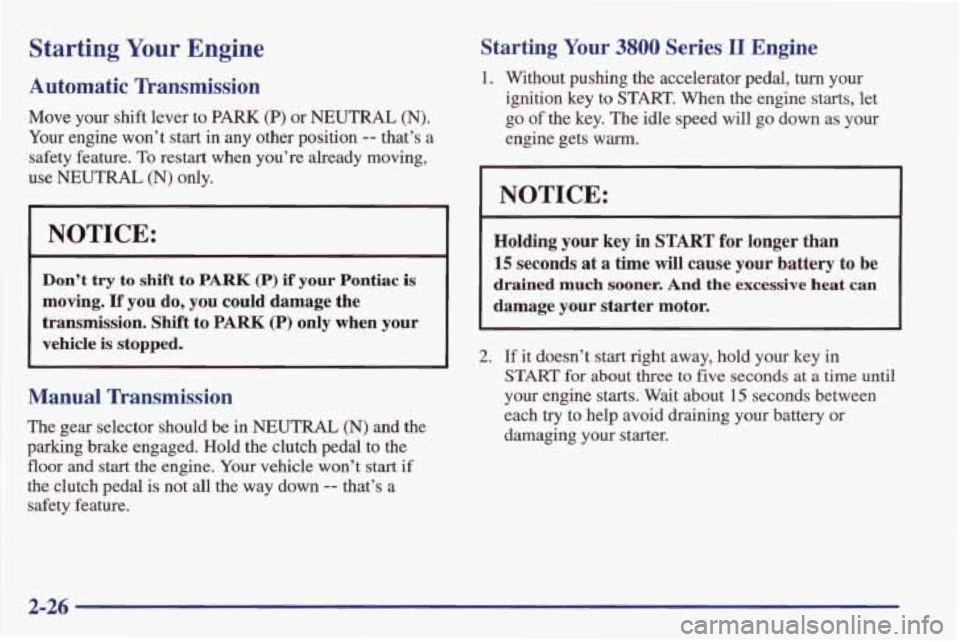
Starting Your Engine
Automatic Transmission
Move your shift lever to PARK (P) or NEUTRAL (N).
Your engine won’t start in any other position -- that’s a
safety feature. To restart when you’re already moving,
use NEUTRAL (N) only.
NOTICE:
Don’t try to shift to PARK (P) if your Pontiac is
moving. If you do, you could damage the
transmission. Shift to
PARK (P) only when your
vehicle is stopped.
Manual Transmission
The gear selector should be in NEUTRAL (N) and the
parking brake engaged. Hold the clutch pedal to the
floor and
start the engine. Your vehicle won’t start if
the clutch pedal
is not all the way down -- that’s a
safety feature.
Starting Your 3800 Series I1 Engine
1. Without pushing the accelerator pedal, turn your
ignition key to
START. When the engine starts, let
go
of the key. The idle speed will go down as your
engine gets warm.
I NOTICE:
~~
Holding your key in START for longer than
15 seconds at a time will cause your battery to be
drained much sooner. And the excessive heat can
damage your starter motor.
2. If it doesn’t start right away, hold your key in
START for about three to five seconds at a time until
your engine starts. Wait about 15 seconds between
each
try to help avoid draining your battery or
damaging your starter.
Page 82 of 406
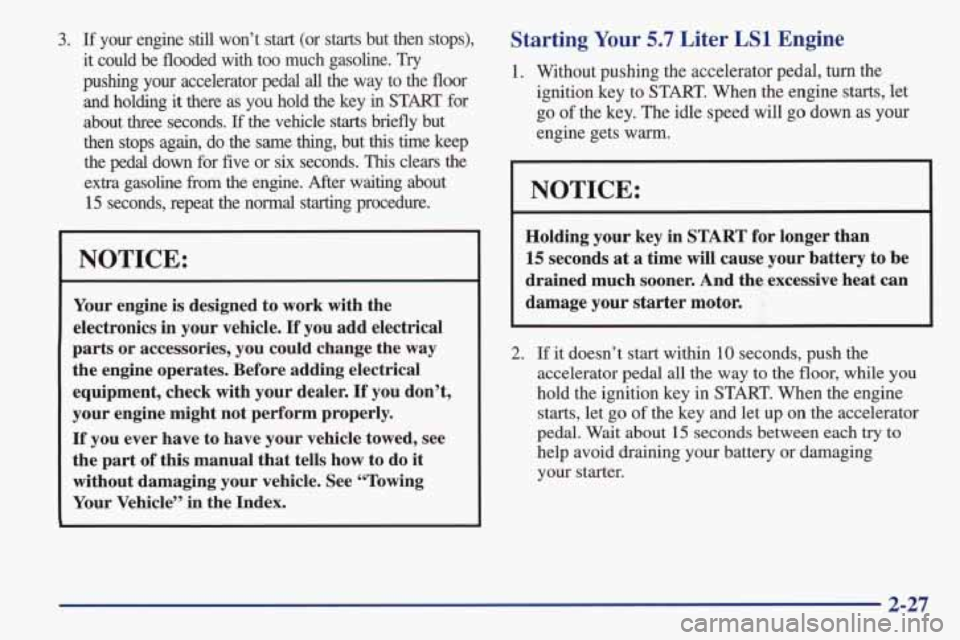
3. If your enpe still won’t start (or starts but then stops),
it could be flooded with too much gasoline. Try
pushing your accelerator pedal
all the way to the floor
and holding it there as you hold the key in START for
about three seconds. If the vehicle
starts briefly but
then stops again, do the same
thing, but this time keep
the pedal down for five
or six seconds. This clears the
extra gasoline
from the engine. After waiting about
15 seconds, repeat the normal starting procedure.
NOTICE:
Your engine is designed to work with the
electronics in your vehicle.
If you add electrical
parts or accessories, you could change the way
the engine operates. Before adding electrical
1 equipment, check with your dealer. If you don’t,
your engine might not perform properly.
If you ever have to have your vehicle towed, see
the part
of this manual that tells how to do it
without damaging your vehicle. See “Towing
~ Your Vehicle” in the Index.
Starting Your 5.7 Liter LS1 Engine
1. Without pushing the accelerator pedal, turn the
ignition key to START. When the engine starts, let
go of the key. The idle speed will go down as your
engine gets warm.
I
NOTICE:
Holding your key in START for longer than
15 seconds at a time will cause your battery to be
drained much sooner. And the excessive heat can
damage your starter motor.
2. If it doesn’t start within 10 seconds, push the
accelerator pedal all the way to the
floor, while you
hold the ignition key in START. When the engine starts, let
go of the key and let up on the accelerator
pedal. Wait about
15 seconds between each try to
help avoid draining your battery
or damaging
your starter.
2-27
Page 83 of 406
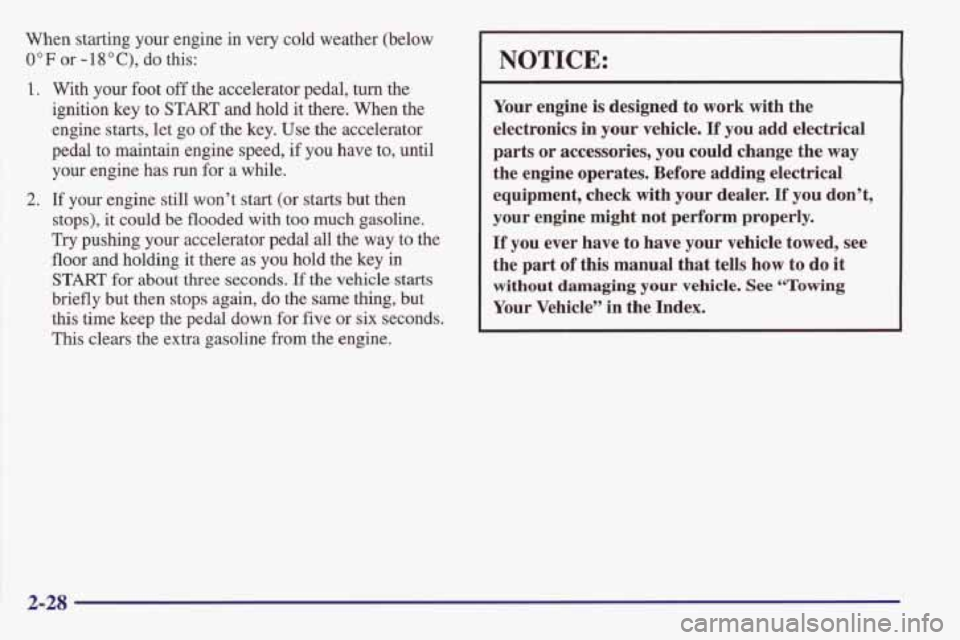
When starting your engine in very cold weather (below
0°F or -18”C), do this:
1. With your foot off the accelerator pedal, turn the
ignition key to
START and hold it there. When the
engine starts, let
go of the key. Use the accelerator
pedal to maintain engine speed, if you have to, until your engine has run
for a while.
2. If your engine still won’t start (or starts but then
stops), it could be flooded with
too much gasoline.
Try pushing your accelerator pedal all the way to the
floor and holding it there as you hold the key in
START for about three seconds. If the vehicle starts
briefly but then stops again, do the same thing, but
this time keep the pedal down for five or six seconds.
This clears the extra gasoline from the engine.
NOTICE:
Your engine is designed to work with the
electronics in your vehicle.
If you add electrical
parts or accessories, you could change the way
the engine operates. Before adding electrical
equipment, check
with your dealer. If you don’t,
your engine might not perform properly.
If you ever have to have your vehicle towed, see
the part
of this manual that tells how to do it
without damaging your vehicle. See “Towing
Your Vehicle” in the Index.
2-28
Page 86 of 406
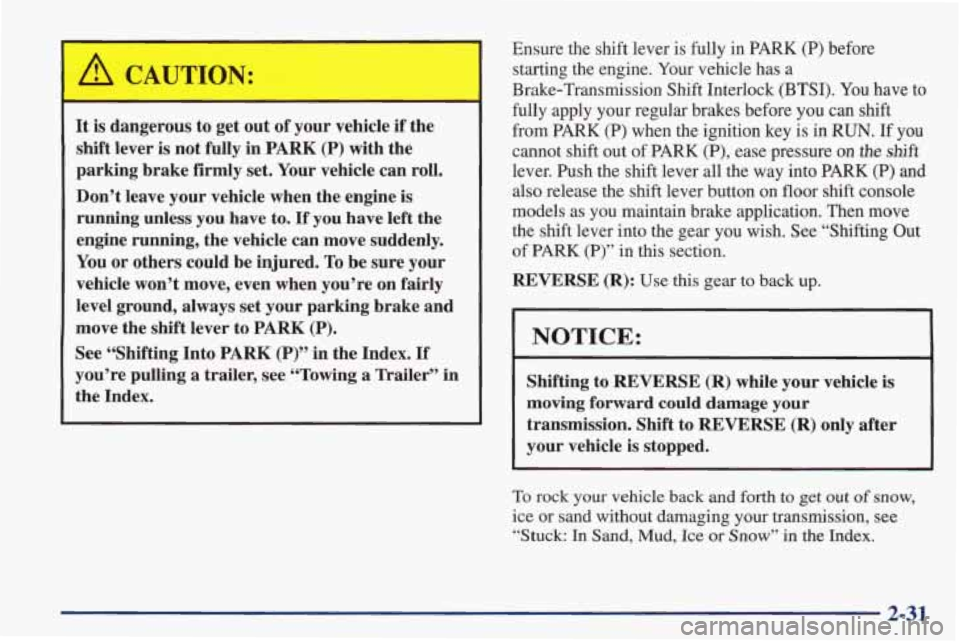
A CAUTION:
It is dangerous to get out of your vehicle if the
shift lever is not fully in PARK (P) with the
parking brake firmly set. Your vehicle can roll.
Don’t leave your vehicle when the engine is
running unless you have to.
If you have left the
engine running, the vehicle can move suddenly.
You
or others could be injured. To be sure your
vehicle won’t move, even when you’re on fairly
level ground, always set your parking brake and
move the shift lever to PARK
(P).
See “Shifting Into PARK (P)” in the Index. If
you’re pulling a trailer, see “Towing a Trailer” in
the Index. Ensure the
shift lever is fully
in PARK (P) before
starting the engine. Your vehicle has a
Brake-Transmission Shift Interlock
(BTSI). You have to
fully apply your regular brakes before you can shift
from PARK (P) when the ignition key is in RUN. If you
cannot shift out of PARK (P), ease pressure on the shift
lever. Push the shift lever all the way into PARK (P) and
also release the shift lever button on floor shift console
models as
you maintain brake application. Then move
the shift lever into the gear you wish. See “Shifting Out
of PARK (P)” in this section.
REVERSE (R): Use
this gear to back up.
I NOTICE:
Shifting to REVERSE (R) while your vehicle is
moving forward could damage your
transmission. Shift to REVERSE
(R) only after
your vehicle
is stopped.
To rock your vehicle back and forth to get out of snow,
ice or sand without damaging your transmission, see
“Stuck:
In Sand, Mud, Ice or Snow” in the Index.
2-31
Page 94 of 406
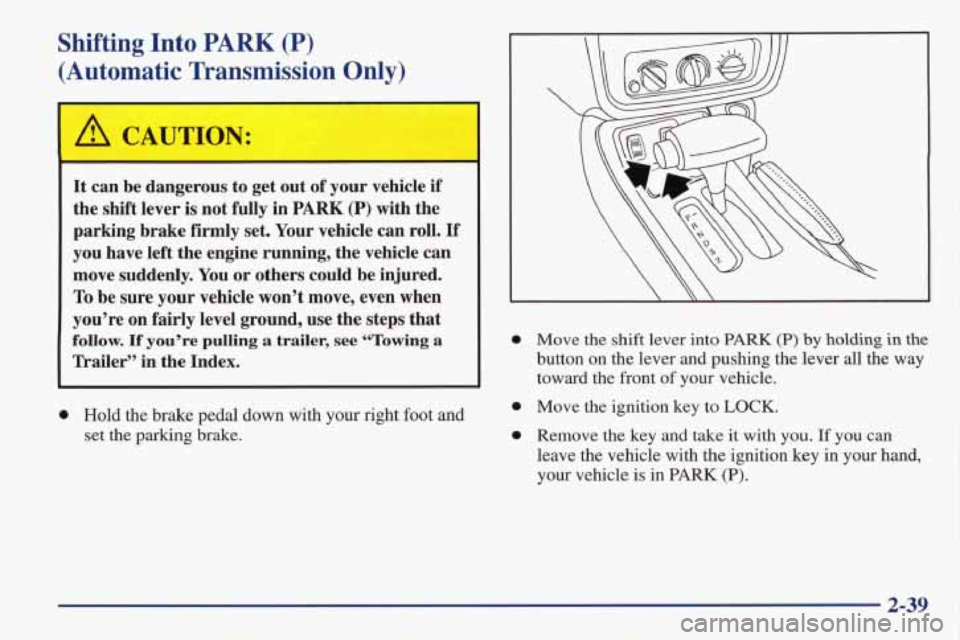
Shifting Into PARK (P)
:Automatic Transmission Only)
A CAUTION:
It can be dangerous to get out of your vehicle if
the shift lever is not fully in
PARK (P) with the
parking brake firmly set. Your vehicle can roll.
If
you have left the engine running, the vehicle can
move suddenly. You or others could be injured.
To be sure your vehicle won’t move, even when
you’re on fairly level ground, use the steps that
follow. If you’re pulling a trailer, see “Towing a
Trailer” in the Index.
0 Hold the brake pedal down with your right foot and
set the
parking brake.
0 Move the shift lever into PARK (P) by holding in the
button on the lever and pushing the lever all the way
toward the front of your vehicle.
0 Move the ignition key to LOCK.
0 Remove the key and take it with you. If you can
leave the vehicle with the ignition key in your hand,
your vehicle
is in PARK (P).
2-39
Page 96 of 406
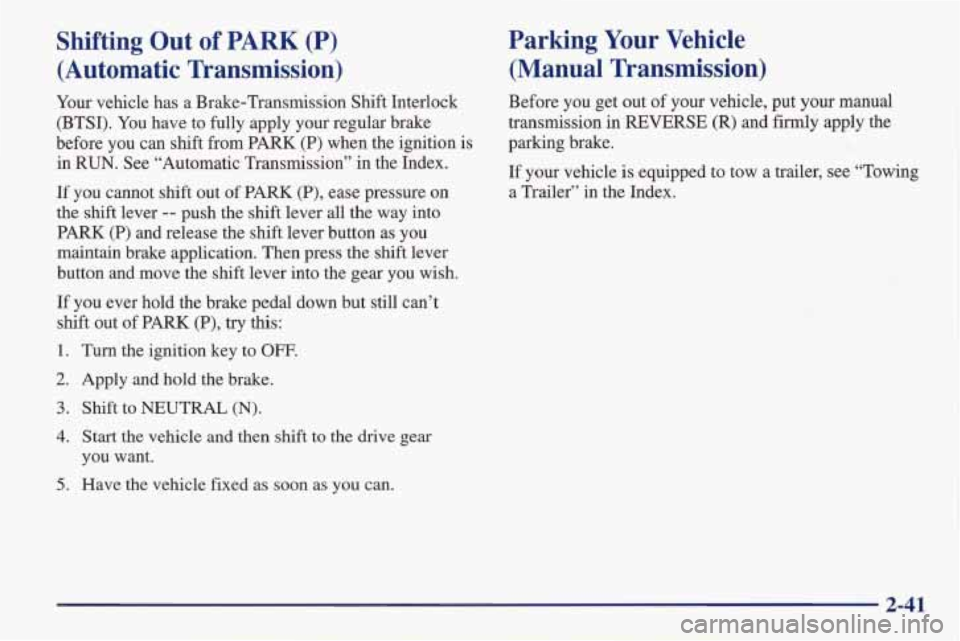
Shifting Out of PARK (P)
(Automatic Transmission) Parking Your Vehicle
(Manual Transmission)
Your
vehicle has a Brake-Transmission Shift Interlock Before you get out of your vehicle, put your manual
(BTSI). You have to fully apply your regular brake transmission in REVERSE \
(R) and firmly apply the
before you can shift from PARK (P) when the ignition is parking brake.
in RUN. See “Automatic Transmission” in the Index.
If
you cannot shift out of PARK (P), ease pressure on a Trailer” in the Index.
the shift lever
-- push the shift lever all the way into
PARK
(P) and release the shift lever button as you
maintain brake application. Then press the shift lever
button and move the shift lever into the gear you wish. If
your vehicle
is equipped to tow a trailer, see “Towing
If you ever hold the brake pedal down but still can’t
shift out of PARK (P), try this:
1. Turn the ignition key to OFF.
2. Apply and hold the brake.
3. Shift to NEUTRAL (N).
4. Start the vehicle and then shift to the drive gear
you want.
5. Have the vehicle fixed as soon as you can.
2-41